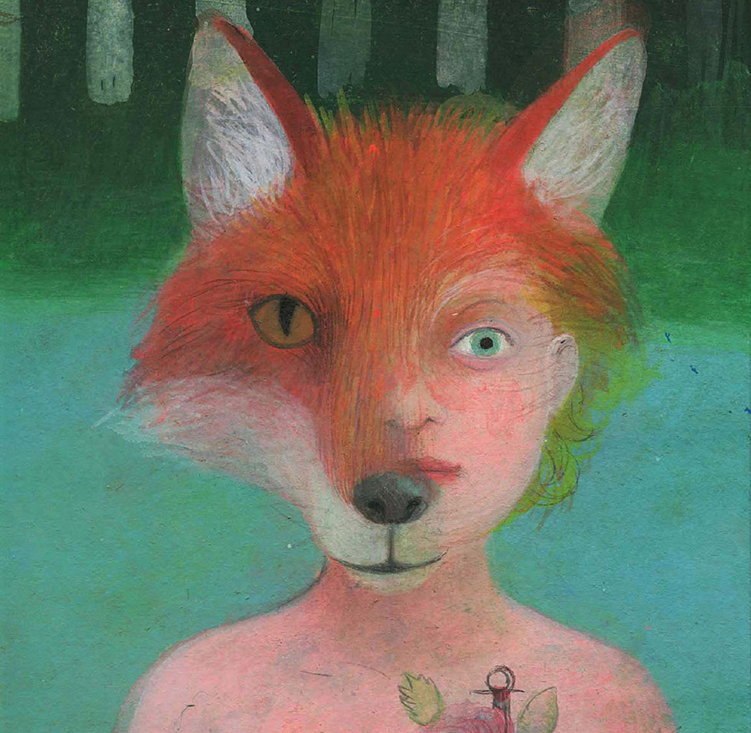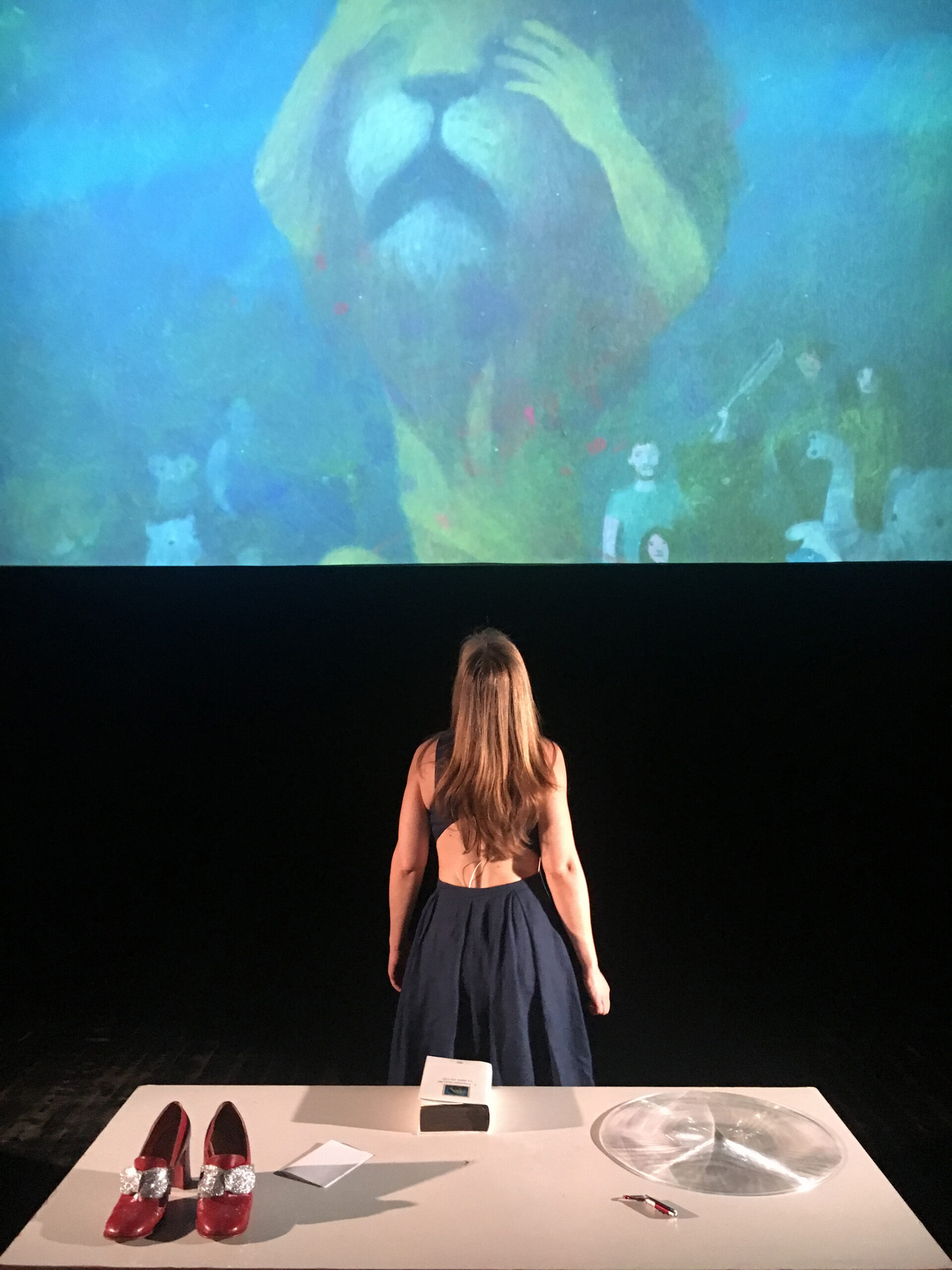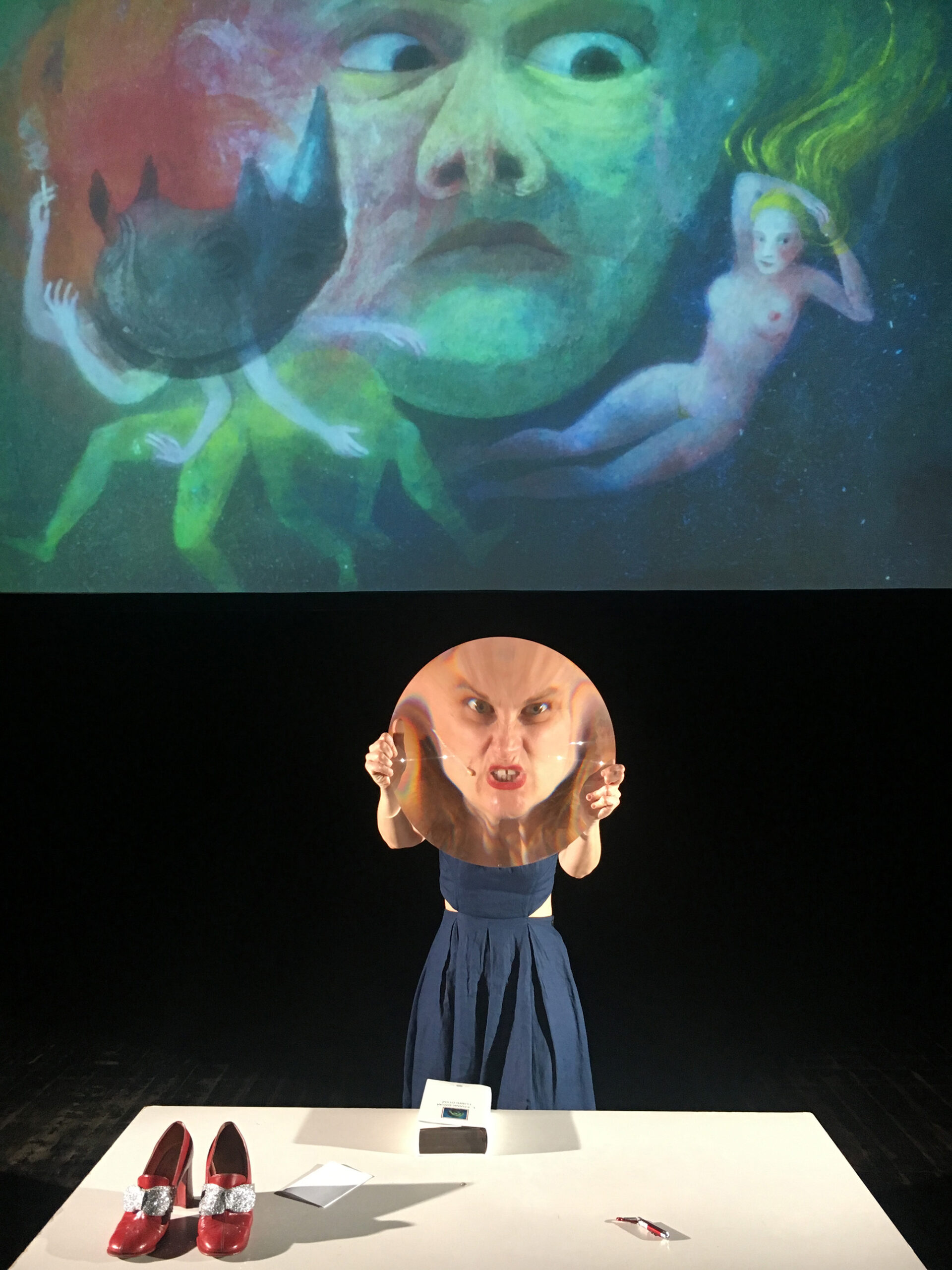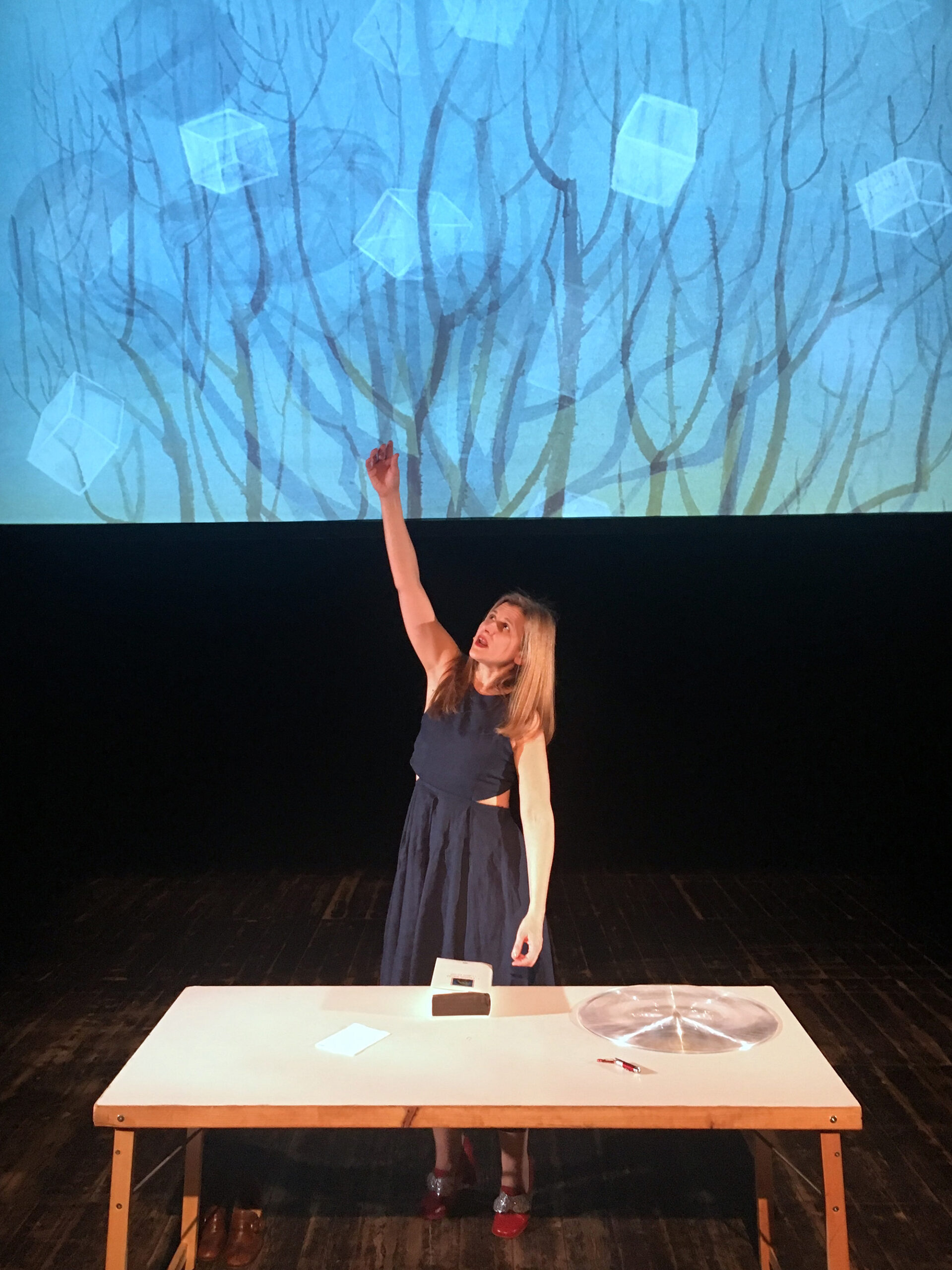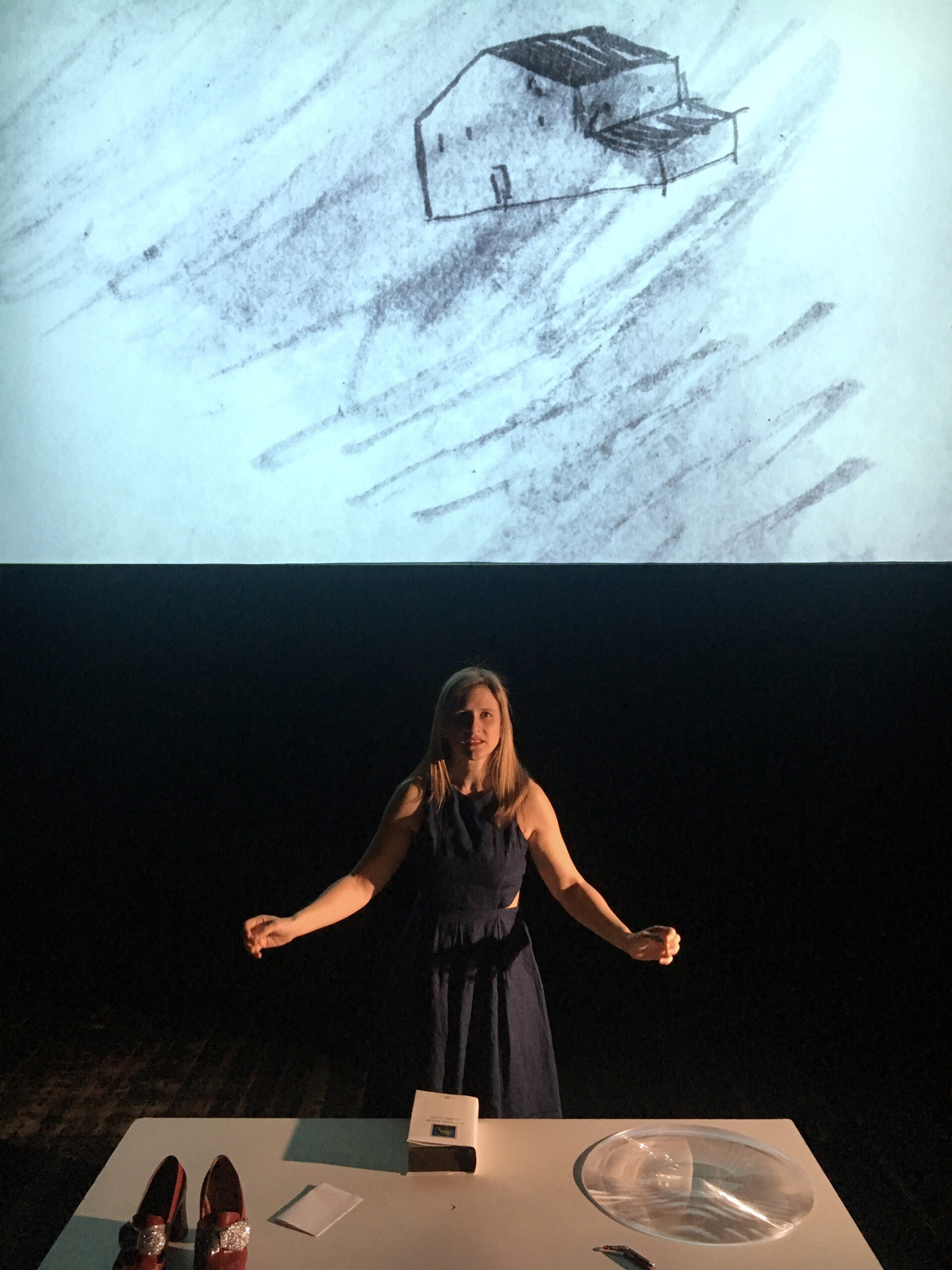I LIBRI DI OZ
by and with Chiara Lagani
- Texts by Frank Lyman Baum,
- translated by Chiara Lagani for Millenni by Einaudi
- Illustrations by Mara Cerri
- Direction and Video Animations by Luigi De Angelis
- Soundscape by Mirto Baliani
- Sound Design and Technical Supervision by Vincenzo Scorza
- Organization by Maria Donnoli, Marco Molduzzi
- Communication and Promotion by Maria Donnoli
- Administration by Stefano Toma, Marco Molduzzi
- Produced by Elastica, E/Fanny&Alexander
After The Wonderful Wizard of Oz, Baum wrote thirteen more novels set in the same world, featuring little Dorothy and her old friends, to which new, no less bizarre and endearing characters were gradually added, such as Scarecrow, the Excessively Over-the-Top Tin Woodman, the hen Billina, the Famished Tiger, the Tick-Tock automaton who thinks and talks only when wound up, and many more. The subsequent novels, though little or not at all known in Italy, are by no means inferior to the original.
Year : 2018
Press Review
Alice del Mutolo, I libri di Oz
Matteo Tamborrino, I libri di Oz. Il ritorno di Chiara Lagani a Baum
Marta Rizi, Il ciclone OZ colpisce le Colline Torinesi
Maria Francesca Sacco, Inequilibrio Festival e le indagini sul reale
I libri di Oz at the Festival delle Colline Torinesi 23, by Alice del Mutolo | Teatro Dams Torino | June 5, 2018
A dark setting, a large white projector standing out at the back of the stage. A black table at the center with a large book, a round magnifying glass, and red shoes placed on top. This is the simple and essential scene of I libri di Oz, a show that was performed on Sunday, June 3 at Caffè Muller for the Festival delle Colline Torinesi.
Chiara Lagani, founder of the Fanny & Alexander theater company, translated and anthologized the fourteen novels by Baum for the Millenni series of Einaudi, all set in the magical world of Oz. She collaborated with illustrator Mara Cerri, who created a series of color and black-and-white drawings to accompany the stories, but more importantly, to offer new interpretive keys and give new life to stories that have accompanied children’s childhoods for over a century.
It is with the aid of these fascinating illustrations, projected behind the actress, and some carefully chosen sounds, that Chiara Lagani begins to tell the spirit of the Oz book cycle. She starts by reading from the book, but what seems like a reading quickly transforms into a full-fledged recital thanks to the actress’s charisma. Even though she is alone on stage, she gives the impression of being surrounded by all the characters she names.
Using a microphone, she creates sound effects and voices for each protagonist that speaks.
Almost like a teacher wanting to teach her students creativity from behind the desk, Chiara Lagani mostly stays behind the table, which may seem a bit static, but thanks to the movement of her upper body and her control and use of voice, she manages to transport the audience into the story she is skillfully telling, capturing their attention throughout.
Through the evocation of these stories and characters, many themes are explored in the anthology, which, while aimed at children, clearly also addresses adults. From imagination to myth, from love to death, the themes are many and all offer food for thought.
I libri di Oz. The Return of Chiara Lagani to Baum, by Matteo Tamborrino | KLP Teatro | June 7, 2018
There are obsessions in everyone’s life. For the Fanny & Alexander company, that obsession is Lyman Frank Baum.
More than ten years after Him, Emerald City, and Kansas, and after having crossed all four cardinal points (bringing Francesca Mazza a nice Ubu Award for West), Chiara Lagani finds herself at Café Müller in Turin – perhaps dropped here by flying monkeys, perhaps clicking her heels three times – choosing to present the audience of the Festival delle Colline Torinesi with a multifaceted reading, featuring excerpts from the monumental (yet still largely unexplored) Oz saga, which she recently translated for the Millenni series of Einaudi: a world – the one created by Baum at the dawn of the 20th century – overflowing with color and modernity, magic and roughness, oddities and pain.
The mise en éspace (coming to Cesena on Sunday, June 10) becomes a true theatrical fable, thanks to the well-paced and never monotonous rhythm of the actress’s voice, dressed in an elegant blue gown. The “soundscape” curated by Mirto Baliani and Vincenzo Scorza is impeccable, allowing, for example, the Lion to speak with a certain naturalism.
The well-known events of the cyclone and Dorothy Gale, the dog Toto, and the impostor wizard mix with those of more obscure characters, at least for us Italians: the fantastical stories of Scarecrow, Billina the hen, and “Lady Woodman” (the beauty of the Tin Man, so to speak) invade the stage, while behind the multi-character protagonist stand the delicate drawings of the illustrator Mara Cerri, a John R. Neill 2.0.
Among all, the most fascinating fragment is the one featuring Lady Ev, formerly the ill-tempered Queen Langwidere, a head-collector who often changes faces, masks, never showing her true self. A perfect example of pre-modern transformation that smells of political relevance.
Before Lagani, a nearly empty table, furnished only with a few stage objects: a convex glass useful for grotesquely distorting the actress’s face when she takes on the role of the wizard, appearing to Dorothy as a floating head; to the left, the iconic red shoes (or silver ones, depending on your choice). Finally, at the center, the published volume, placed as a sort of Holy Scripture.
Indeed, the saga was immediately a classic of the North American canon, so much so that today – alongside the fourteen author’s novels between The Wonderful Wizard and Glinda of Oz (written by Baum between 1900 and 1920) – there exists an almost innumerable number of apocryphal works and rewritings.
“I libri di Oz,” writes Lagani, “are a small encyclopedia of famous themes. One can talk, from time to time, about myth, history, political systems, and fantastic constitutions.” The translator-actress also has strong geographical interests: showing off a detailed map of all Nonestica, she gives a public reading. The key to understanding it is simple: you can reach Oz in many ways (mostly abrupt ones). But it doesn’t matter how you get there. What matters is getting there. And being astonished by its phantasmagoric beauty: “Definitely not Kansas!” Judy Garland comments dreamily.
A pleasant recital, at times pleasantly “nocturnal,” that, without exaggerating or being exaggerated, teases the audience’s imagination, even drawing a few smiles.
The Oz Cyclone Strikes the Hills of Turin, by Marta Rizi | Lettera 22 | June 8, 2018
From under the porticos, we gaze at the sky, grayer than usual – is another hurricane on the way? Before being lifted into the air by a tornado, we slide down to the basement, into the belly of Caffè Müller, for the third (rainy) evening of the Festival delle Colline. I haven’t made any reference to descending into the White Rabbit’s hole, though the blind and wondrous space of Müller could induce such a comparison.
Indeed, either you’re with Alice, or you’re with Dorothy, as Ray Bradbury used to say. And tonight, we’re all with Dorothy. Her magical red shoes are already there, promising to meet not one but fourteen Wizards of Oz. Because that’s how many books Frank Baum wrote about that fantastic world, translated and curated for the Millenni series of Einaudi by Chiara Lagani, pillar of Fanny & Alexander and for the first time in the role of official translator – though she’d unofficially been translating them for years, as she tells us at the end of the performance. I libri di Oz is a duet for voice and color, performed by Lagani and painted by Mara Cerri, author of the book’s illustrations, which also accompany the recital. The narrative stitches together characters and events from the many books into a cohesive plot, giving us the impression that it’s one single, great novel.
Like children, sitting on chairs or stools, or on the floor on red cushions like Dorothy’s red shoes, we listen, captivated, to the story of the Kansas girl and her tin and straw friends, and many other stories never before heard, where we meet Tic-Toc, an automaton who can think, talk, and move as long as it’s wound; a cruel princess with 100 interchangeable heads; Miss Cutout, creator of magical and fragile paper girls. Chiara Lagani is a Dorothy-storyteller, her many voices guide us through the kaleidoscopic universe of Oz with the passionate grace of children. Mara Cerri’s illustrations, both ethereal and expressionistic, appear and disappear from the large screen before us like dreams, invoked to be undone and transformed into something else.
Transformation is at the heart of the world of Oz: in Lagani’s recital, the richness of stories, voices, and bodies is summed up in one sole interpreter, who, from storyteller character, becomes almost an imaginative priestess capable of shaping astounding worlds and beings with her words. When she falls silent, unmistakable echoes of the famous film by Victor Fleming, like an unexpected sound madeleine, carry us even further, to the time when we were children like Dorothy. “Shall we play together?” This is one of the opening lines of Ponti in Core, the play that brought Fanny & Alexander to critical attention in the mid-nineties. A quarter of a century later, the Ravenna-based company, which celebrated 25 years of career in 2017, continues to renew itself and play with purity, enchantment, and darkness, as only true children can: “There is no being more amazed in the world, and more ready for the mystery of life and death, than the child,” says Chiara Lagani. This is what wizards, fairy tales, and theater are for – to bring us back to being children in order to rediscover knowledge and renewal. Childhood is a theme that permeates the poetic vision of Fanny & Alexander, starting with their name, inspired by Bergman’s film of the same title, whose protagonists are two children, and continuing with I libri di Oz, which is clearly dedicated to this time of life. Just like Dorothy, who is always ready to return to Oz by following the magic that calls her to it.
Inequilibrio Festival and the Investigations on Reality, by Maria Francesca Sacco | KLP Teatro | June 10, 2018
A few months ago, the Inequilibrio Festival went through several experiences, and at the heart of the second tour, the festival took a different direction, opening doors to deep cultural analysis, not just entertainment. The investigation of reality, which intertwines with the formation of new forms of communication. What did it mean to bring I libri di Oz to the public at such a time? The choice to revisit Baum’s Oz world is all the more relevant for the present age, in light of the tendency to look backward for answers. The retrospective vision, the return to childhood, and the feeling of wonder—mixed with a pinch of nostalgia—create a perfect atmosphere that touches deeply in this historical moment. Chiara Lagani’s minimalist approach lets us immerse ourselves completely in the magical world while making it clear that it’s not just a fairy tale world, but a reflection of the reality we live in, especially when we think about Baum’s visionary themes. What’s left to investigate is the possibility of connecting this process with the essence of reality and how much childhood’s magic has the power to shape today’s art.
Chiara Lagani, founder of the Fanny & Alexander theater company, has in previous years staged a series of performances based on the Oz books. Now, for the Millenni series of Einaudi, she has translated and anthologized the fourteen novels, writing the connections between episodes to provide the necessary information about the omitted parts, and has added brief notes to the volume that highlight further references across the various tales. In collaboration with her, Mara Cerri has created a series of color and black-and-white illustrations that accompany the stories of Dorothy and her companions.
The recital invites the audience to ideally explore, through the voice of Chiara Lagani and in about an hour of performance, the spirit of the Oz book cycle, moving from one novel to another as if they were chapters of a single great story that has been subject to various interpretations, from political to religious, gnostic, and psychoanalytic ones.
Each performance will feature a guest who will provoke discussion on different themes: the Oz books are a small encyclopedia of famous topics. Topics such as myth, history, political systems and fantastic constitutions, wordplay, famous brains and hearts of history, utopias, the fascination with technology and science, feminism, and more, will be explored.
The true value of these novels lies precisely in their refusal to be confined to any interpretive framework. Baum’s narrative freedom, his continuous fantastical invention, the hilarious word games, the emotional ambivalence between comedy, fear, and melancholy, have always sparked a mysterious complicity with readers of all ages, belonging to the pleasures of intelligence and the essence of true literature.
